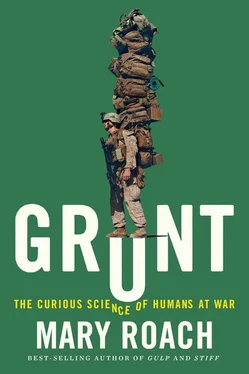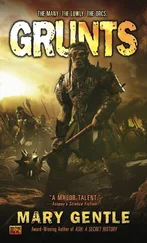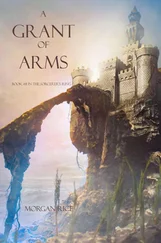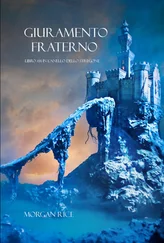THE AUTOPSY room smells like summer. The exhaust system has an air intake from outside, explains AFMES public affairs officer Paul Stone, who is taking me around this afternoon. “They just mowed the grass out there.” The room is large enough to accommodate twenty-two autopsies at once. Stone was here the week a Chinook helicopter was shot down in Afghanistan, killing thirty-eight people and a military working dog. Then, it smelled like jet fuel and burned flesh, so powerfully that Stone’s dry cleaner charged him double. “He said, ‘What were you doing ?’” Stone used to be a spokesperson at the Office of the Secretary of Defense. It’s tough to rattle him. At one point I asked if people tell him he looks like Vladimir Putin, and not even that did it.
At the peak of the Iraq war, twenty or thirty bodies passed through this room each week. Since 2004, around six thousand autopsies have taken place here. Every person (and dog) who dies in the service of the US military is autopsied. It was not always this way. Before 2001, autopsies were reserved for cases in which there was no witness to the death, or the cause was not obvious. Stone gives the example of a suspected homicide, then pauses. “Though technically it’s all homicide.” Homicide , from the Latin homo , for man, and - cidium , the act of killing. He means murder: prosecutable homicide.
Six thousand homo s cidium ed in the prime of their lives. What does this job do to a person? For one thing, it makes him very tired of that question. “We’re doctors, and these are our patients,” was the stock answer I got. I imagine it’s a tough kind of doctor to be. Most people study medicine with the hope and intent that their work will restore health, end pain, extend lives. Save lives. Because of Feedback to the Field, the work of these medical examiners does save lives. But not the ones they interact with day to day.
Stone brings me over to the H. T. Harcke Radiology Suite, where dead men and women are given CT scans. A whole-body CT is a heavy dose of radiation, but the dead don’t have to worry. Certain things like bullet trajectories and angles of entry are easier to see in the clean, gray-scale imagery of a CT scan than they are in a flesh-and-blood autopsy. Colonel Harcke himself is on hand to show me the basics of forensic radiopathology. He is the Harcke for whom the lab is named. I assumed that this was in tribute to his pioneering contributions to the field. “There’s two ways that happens,” he says when I mention it. “Die or give two million dollars. I’ll let you figure out which it is.”
Using a mouse, Harcke scrolls through the topography of an anonymous body. As we travel from scalp to boot heel, IED fragments flare like supernovae. Metal reads as bright white against the grays of muscle, blood, and bone. [62] Usually the victim’s, but occasionally a fragment from a suicide bomber. According to Stone, there has not been a documented case in which a piece of a terrorist’s bone was the cause of death. (Medical examiners do not use the term “organic shrapnel.” That originated in Falling Man author Don DeLillo’s cranium.)
The contrast is stark and telling. In the face of velocitized steel, even the strongest among us are mush. Fragility is evident even in the terms MEs use— soft tissue, an eggshelled skull .
On the way back to Stone’s office, we stop to talk with Pete Seguin, the statistics guy. On his desk is a sheaf of photographs, printouts of the cases from the combat mortality meeting. “They don’t look real,” he says of the bodies. “They’re like dolls.” I’m not sure where he’s buying his dolls. I look at Stone.
“He means porcelain dolls,” Stone says. “The white skin.” Seguin explains lividity, the pooling of blood in a corpse. When the pump shuts down, gravity takes over. Because the dead are transported on their backs, they come to autopsy white as geishas, the blood drained from the face, chest, the tops of the legs.
“But then you see them back there…” Seguin means in the autopsy room. “That’s a whole different experience. It’s too sad.” I can barely hear him. “These are all young people. Our kids. It makes you ask questions. Like, Was it worth it?”
In the autopsy room there’s a pair of platformed aluminum stepladders on wheels. I thought the ceiling was being repaired. “No, it’s for perspective,” Stone had said. The autopsy photographers need to get up high to get the whole body in the frame. I guess war is like that. A thousand points of light, as they say. Only when you step back and view the sum, only then are you able to grasp the worth, the justification for the extinguishing of any single point. Right at the moment, it’s tough to get that perspective. It’s tough to imagine a stepladder high enough.
This book began with an email from a reader: Brad Harper, a retired Army pathologist. In the course of our correspondence, I mentioned I’d been toying with the idea of a book on military science but had assumed that access would trip me up. Should I try it anyway? Yes, insisted Harper. He brought me to the military morgue in Dover and introduced me to colleagues. He took me to USUHS to see his friend Sharon Holland, who has contacts all over the military medical world. When I allowed that one of the things I wished to write about was genital trauma, Holland did not flinch. She picked up the phone and called James Jezior at Walter Reed. Hey, Jim, might you have a surgery this writer could observe? Yes, said Jezior. Though he’d need to ask the patient. And surely here would be my first no: Hey, Captain White, could some strange writer lady come out and watch your operation? But White, too, said yes.
And so it went. Over and over, when the easy answer, the sane answer, was no, people said yes.
Hey, Jerry Lamb, ridiculously busy technical director at the Naval Submarine Medical Research Laboratory, could you find someone to approve my spending a few days at sea on a Trident submarine? Though it’ll take fourteen months and two-hundred-some emails to make it happen? Yes, said Lamb.
And might that submarine be yours, Chris Bohner and Nathan Murray of the USS Tennessee? Though I’ll be traipsing through the missile silos with no security clearance? Yes, they said. Bring your notebook and your dingbat questions. Kick Kedrowski out of his rack. Tie up the head every morning.
Hello, Mark Riddle, could I follow you to Camp Lemonnier, Djibouti, even though it means you’ll have to escort me all day every day for an entire week? And then later will you spend your holidays reviewing my manuscript?
Hey, Randy Coates, and hey, Rick Redett, I hear you’re doing some cadaver trials. Could I join you?
Hey, Kit Lavell, hey, Eric Fallon, could you work me into combat simulations where I don’t belong?
Again and again, I expected to hear no , yet yes was what I got. These fine people put their reputations on the line. They spent time they could not spare. They spoke openly on issues more comfortably left alone. For all of this—to all of you—I am deeply, humbly, gobsmackedly grateful.
I have no background in medicine or the military, and this fact made me an exasperating, time-sucking presence in people’s days. Certain individuals must be thanked for the hours spent explaining their work and, in some cases, the most basic elements of the science: Rob Dean, Christine DesLauriers, Molly Williams, Benjamin Potter, and Stacy and Mark Fidler at Walter Reed National Military Medical Center; Doug Brungart, Ben Sheffield, George Peck, Dan Szumlas, and Pete Weina at Walter Reed Army Institute of Research; Natalie Pomerantz, Sam Cheuvront, Peggy Auerbach, Rick Stevenson, and Annette LaFleur at US Army Natick Soldier Research, Development and Engineering Center; Alan Hough and Eric Nabors at the US Navy Submarine School; Kate Couturier, Ray Woolrich, and Shawn Soutiere at Naval Submarine Medical Research Laboratory; Dianna Purvis, Patty Deuster, and Dale Smith at Uniformed Services University of the Health Sciences; Mark Roman at Aberdeen Proving Ground; Ken Tarcza, Jason Tice, and Patti Rippa of the Warrior Injury Assessment Manikin project; Nicole Brockhoff in the Office of the Director, Operational Test and Evaluation; Aaron Hall and Dave Regis at the Naval Medical Research Center; Theodore Harcke and Edward Mazuchowski at the Armed Forces Medical Examiner System; John Clark of the Royal Navy, and Michael White. I came to you all as an ignoramus and an outsider, and you treated me as neither.
Читать дальше












